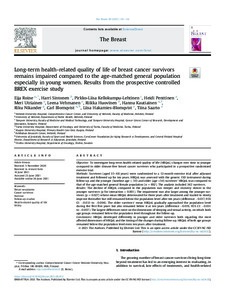Long-term health-related quality of life of breast cancer survivors remains impaired compared to the age-matched general population especially in young women Results from the prospective controlled BREX exercise study
Kellokumpu-Lehtinen PL; Nikander R; Blomqvist C; Hakamies-Blomqvist L; Utriainen M; Kautiainen H; Huovinen R; Sintonen H; Saarto T; Penttinen H; Roine E; Vehmanen L
https://urn.fi/URN:NBN:fi-fe2021102752641
Tiivistelmä
Abstract
Objective
To investigate long-term health-related quality of life (HRQoL) changes over time in younger compared to older disease-free breast cancer survivors who participated in a prospective randomized exercise trial.
Methods
Survivors (aged 35–68 years) were randomized to a 12-month exercise trial after adjuvant treatment and followed up for ten years. HRQoL was assessed with the generic 15D instrument during follow-up and the younger (baseline age ≤ 50) and older (age >50) survivors’ HRQoL was compared to that of the age-matched general female population (n = 892). The analysis included 342 survivors.
Results
The decline of HRQoL compared to the population was steeper and recovery slower in the younger survivors (p for interaction < 0.001). The impairment was also larger among the younger survivors (p = 0.027) whose mean HRQoL deteriorated for three years after treatment and started to slowly improve thereafter but still remained below the population level after ten years (difference −0.017, 95% CI: −0.031 to −0.004). The older survivors’ mean HRQoL gradually approached the population level during the first five years but also remained below it at ten years (difference −0.019, 95% CI: −0.031 to −0.007). The largest differences were on the dimensions of sleeping and sexual activity, on which both age groups remained below the population level throughout the follow-up.
Conclusions
HRQoL developed differently in younger and older survivors both regarding the most affected dimensions of HRQoL and the timing of the changes during follow-up. HRQoL of both age groups remained below the population level even ten years after treatment.
Kokoelmat
- Rinnakkaistallenteet [19207]
